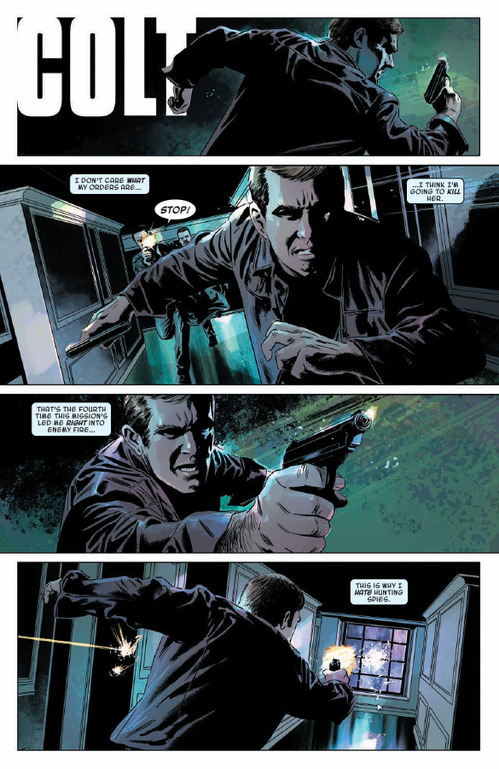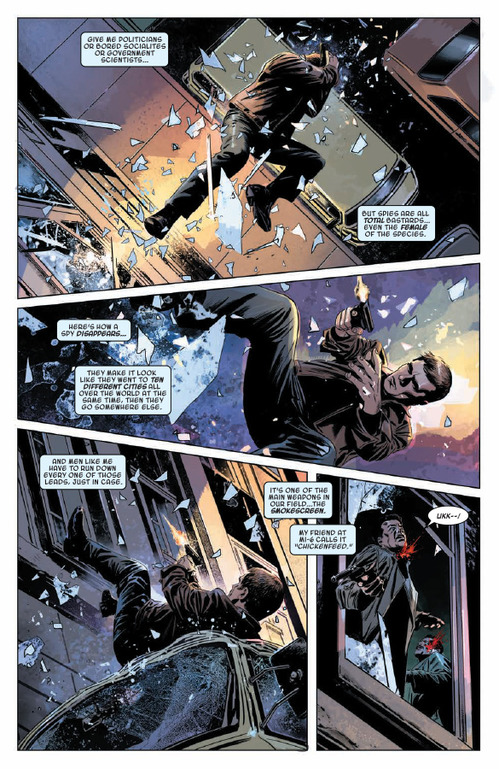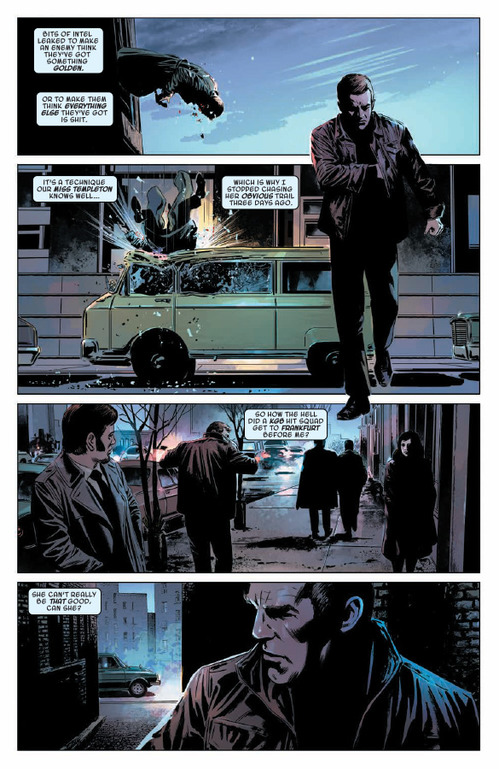Ed Brubaker understands spy fiction: the undeniable seductions of knowing the unknown, the tangled webs of deception and the consuming flirtations with death. The iconic comic scribe also understands that readers secretly crave access to these globetrotting adventurers and death-defying exploits. It’s why the work of long-standing authors like Ian Flemming and John le Carré continue to be adapted for modern film audiences.

But comics are Brubaker’s domain, and he’s damn good at making them; the latest evidence is Velvet, an ongoing Image series that explores the dark underbelly of international espionage. However, Brubaker, along with Captain America partner-in-crime Steve Epting, shrugs off the machismo conventions typical of Hollywood’s conventions, and instead focuses on Velvet Templeton. This smoldering femme fatale, fulfilling the Moneypenny role of clandestine organization ARC-7, erects a steely veneer hiding a decade of wars and turmoil. As she looks for answers to questions buried in her past, she must also traverse a spy network out for blood.
As this series propels through its second arc, Paste caught up with Brubaker to talk about his particular penchant for spycraft and why comics are the perfect medium for both espionage and explosions. Also keep an eye out for Paste’s review of Brubaker’s new comic, The Fade Out, with pencils from Sean Phillips.
Paste: In past series, such as Incognito and Fatale, your letters and back matter have always highlighted your love for spy and noir fiction. You’ve worked on supernatural noir, and super-powered spies, and even your Marvel work tapped into that Cold War spy fiction vein. When you conceived this story, what was the original idea or thought that grew into Velvet?
Brubaker: Velvet was something that sort of gnawed at me for years because of a love of old spy movies and characters like Modesty Blaise and the Black Widow. Or stuff like that old movie Deadlier Than the Male, and Raquel Welch in Fathom. I grew up watching all those movies and stuff like Danger: Diabolik. So the original idea was just looking at those kinds of stories and fictional spy worlds from a slightly different perspective, and then Greg Rucka made me watch The Sandbaggers and there was a whole episode about the Director of MI6 needing to find a new Girl Friday. All those things combined to spark my imagination.
And then after the initial idea — and the name — I spent about six or seven years figuring it out and waiting for Steve Epting to be done with his Marvel contract so we could do it. And in those years, Velvet’s history and my ambitions for the series really changed and grew into something much more their own thing.
Paste: What I’ve loved about Velvet from the very opening pages was how it battles against the reader’s preconceived ideas of spy stories. We see our stereotypical spy in X-14 get blown away before the title page, and transition to Velvet, a “secretary” who is much more than she seems. Velvet Templeton is a powerful woman in a decade and field that is often portrayed as male-dominated. Was this commentary on gender roles something you wanted to explore when writing Velvet?
Brubaker: I don’t know if I’d say I want to explore any specific thesis, as much as try to tell an intriguing story, but part of why Velvet is interesting to me is writing about a woman in that world, certainly. That’s another reason it takes place during the Cold War, because that was also a period of massive cultural change around the world, and a big part of that being the women’s movement. So yeah, an overlooked woman in that era turning out to be one of the deadliest people alive is a lot of fun to explore.
Paste: Velvet Templeton is a character who lives on two emotional extremes. She’s a cold and calculating spy, but also has love for her husband and empathy for other characters. Is it hard to write a character that lives on such opposite ends of the emotional spectrum?
Brubaker: Not really. All spies, I would imagine, have to compartmentalize, if they’re going to survive in that world. Half their lives are lying and acting, but there’s got to be a real person in there somewhere. Everyone puts on masks in life, so that’s not hard to imagine, as a writer, really. And it makes her fun, because she has so many different sides. She’s like the D20 of main characters.
Paste: There’s a moment in the fourth issue when Velvet begins talking about “broken soldiers” — how all these characters seem hopelessly trapped in this constant circle of violence. Since we don’t know several characters’ motivations, it sometimes seems like violence without purpose. Can you talk a little bit more about that scene and what it reveals about this comic and its characters?
Brubaker: One of the things Velvet’s narrative comes back to is the world these characters live in — the world of “the game” of espionage. The world of secrets. The idea being this world is so seductive because you might get to know the true stories behind why a Shah died in his sleep, or who killed a President or when someone almost fired nuclear missiles at England… I mean, the kind of thing the mass of the world doesn’t know or want to know about, and that once you’re a part of this other world, you can’t go back to the one we all live in. The regular world.
And especially in Velvet because so many of the people in that era’s espionage world are men and women scarred from World War II and the battles that followed it into the Cold War. And since they can’t go back to regular life, they’re basically willing pawns in an endless war.
Paste: What were some scenes or sequences that really impressed you once you saw Epting’s pencils bring them to life? Any surprises?
Brubaker: All the art for Velvet has really wowed me so far. I think issue five is the best art Steve’s ever done. The biggest surprise I guess was watching Steve’s style evolve over the last year as he’s turned in pages. He’s always been good, but he’s really embraced the shadows of Velvet’s world and given us this chiaroscuro look sometimes. I’ve gotten rid of captions and sound effects in the final proofing sometimes because I just don’t want to cover his and (colorist) Bettie (Breitweiser)’s art, and what he’s done says more than my words could have anyway.
Paste: Last month you began the second arc to Velvet. Now that the groundwork is set, what can we expect from this series going forward?
Brubaker: Well, Velvet’s found one answer, a bad one, and all it did was give her more questions she can only get answered back in London, so she’s going home with vengeance in mind. She’s just not sure who to get it from, yet. And issue seven (out on Wednesday), the second chapter of this arc, is all told from the point of view of the men hunting her, which was a blast to write. This part of the book really fleshes out the rest of her world, too, and more of the history of ARC-7 where she works, which is actually a secret international agency. They’re not just British.
Paste: Spy fiction seems to have an endless audience, which possibly explains the 23 Bond films and successful new franchises like the Bourne films, but you’ve been a champion for bringing spy comics back to a modern audience. What is it about this genre that’s so endlessly captivating?
Brubaker: Because just like spies get seduced by that world of secrets, so do readers. We love to find out top secrets and watch agents risking their lives to stop madmen from killing whole countries.
For me, comics is a perfect medium for a good spy story because we do shadowy meeting rooms and big explosive action really well in comics, so it lets me try to straddle the line between things like Bond and Mission Impossible, and Tinker, Tailor, Soldier, Spy and The Sandbaggers.
Darren Orf is a contributing writer with Paste who spends his days writing about technology at Gizmodo.


